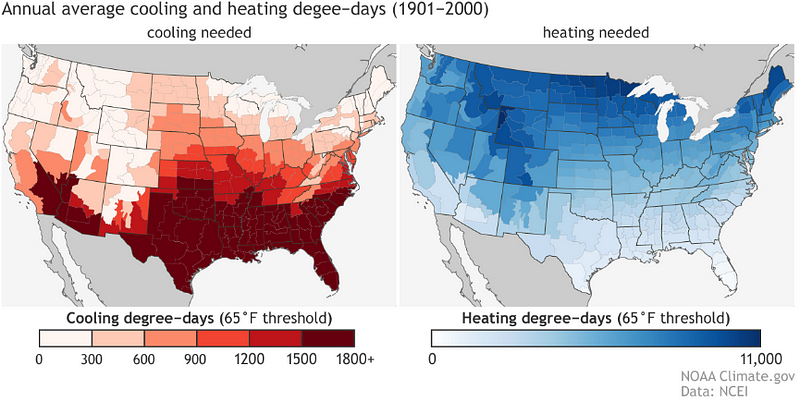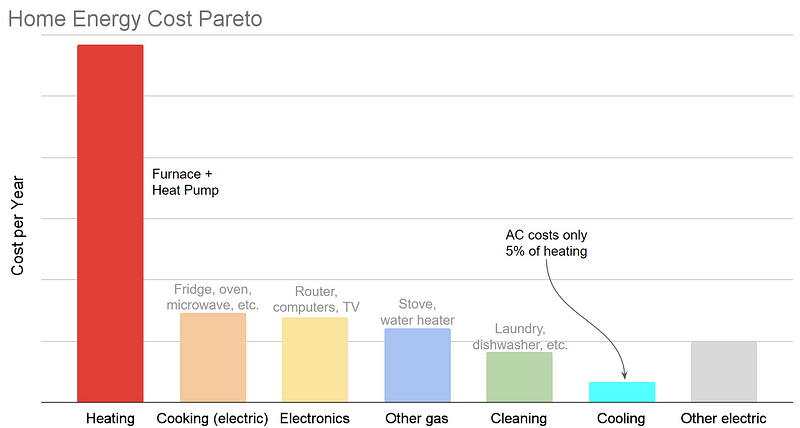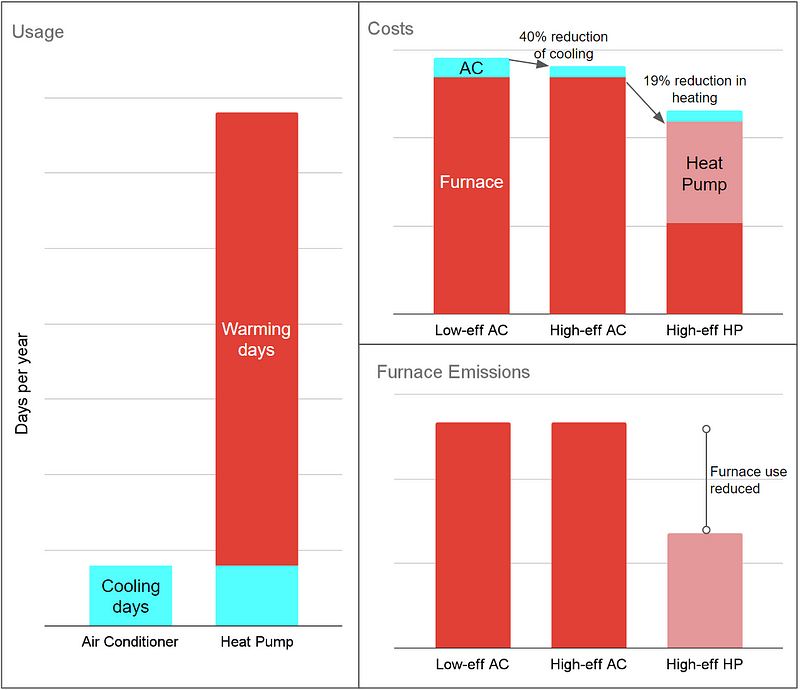Optimize Your Home's Heating: Strategies for Summer and Beyond
Written on
Chapter 1: Understanding Heating Costs
As summer approaches, it’s easy to shift focus to cooling solutions, but it’s also a prime time to consider your heating system. When I first settled into my home, I dedicated a year to exploring ways to keep it cooler during the warmer months. I contemplated installing a light-colored roof or an attic fan to mitigate solar heat. To my astonishment, I discovered that my heating expenses far exceeded my cooling costs by a staggering ratio of over 20 to 1. In fact, my heating bills were greater than my combined expenses for cooling, cleaning, and cooking. This realization highlighted a significant oversight in my energy management.
Most likely, if you’re reading this, your energy consumption mirrors mine—this is a common trend across the developed world. Focusing on the largest energy expenditure, which is heating for many, yields the best return on investment while also reducing overall energy costs and emissions. You might wonder: Do I live in an area that requires significant heating?
Yes, probably. To grasp this better, let’s examine Heating Degree-Days (HDD) and Cooling Degree-Days (CDD), which help quantify the heating and cooling requirements of different regions.
The standard method for calculating HDD and CDD involves taking the average daily temperature and subtracting 65°F (18°C). Any positive result indicates CDD, while negative values indicate HDD. For instance, if the average temperature in a town is 75°F, the CDD for that day would be 10. Assuming this temperature persists throughout summer and the average drops to 55°F in other seasons, the annual CDD would total about 920 (92 days x 10°F), and the HDD would be approximately 2730 (273 days x 10°F).
Understanding HDD and CDD provides insight into not just the extremity of temperatures but also the duration of the heating and cooling seasons. Areas with higher HDD often face steeper heating bills, and the same logic applies to regions with high CDD. While HDD and CDD typically exhibit an inverse relationship, some locations with significant seasonal fluctuations can experience both high HDD and CDD.
Section 1.1: Assessing Your Climate
Below are some visual representations comparing Heating Degree-Days (HDD) to Cooling Degree-Days (CDD).

Figure 1: CDD and HDD across the United States. Note the HDD scale is six times greater than that of CDD. Only the southernmost areas show a higher CDD than HDD.

Figure 2: HDD and CDD for Western and Central Europe. Source: PVsites.eu “European climate zones and bioclimatic design requirements” Jan 2016.
In the United States, nearly everyone outside of Hawaii, southern Arizona, and the immediate Gulf of Mexico vicinity is situated in a heating-dominant area. Even Los Angeles recorded more HDD (1274) than CDD (679) in 2022, according to the HUD HDD database. In Europe, significant cooling zones are mostly restricted to parts of Spain, Italy, Greece, and a few smaller regions.
If you reside in one of these cooler climates, some of this content may be less applicable to you. I plan to write a follow-up article focusing on enhancing cooling systems. Generally, in a cooling environment, a high-efficiency heat pump with a high SEER rating is likely the best choice for both heating and cooling needs.
For the majority who live in heating-focused climates, let’s explore why heating efficiency is crucial for both cost savings and environmental impact.
Section 1.2: The Financial Impact of Heating
Below is a breakdown of my natural gas and electricity expenses over a twelve-month period, from May 2022 to April 2023.

Figure 3: Key components of my home energy expenses. Data compiled using a wattmeter, utility bills, and hourly electricity usage logs.
Heating costs accounted for nearly half of my total energy expenditures. Any improvements made to other appliances will have a minimal effect when compared to optimizing heating. Take a moment to review your bills and energy consumption. Estimating the percentage of your heating equipment expenses relative to your total bills shouldn't be too difficult. I suspect many will find their heating costs are even higher than mine for several reasons: I live in an area with relatively mild winters compared to much of the US and Europe (our winters are warmer than St. Louis but colder than Atlanta). Additionally, I maintain a wide comfort range, keeping my thermostat set at 65°F (18°C) in winter. Lastly, my heating system is already quite efficient, having switched to a high-efficiency heat pump, which lowered my heating expenses significantly.
What should my next steps be?
As summer arrives, we might be tempted to prioritize upgrades for efficient cooling, but this is not the best approach. Given the high costs of heating, we should first focus on optimizing this aspect before exploring other categories. Upgrading cooling systems or other non-heating categories often yields minimal savings. Instead, consider summer a brief respite from heating demands, which provides a chance to enhance your heating system.
Avoid the temptation to purchase an air conditioner; instead, look into a heat pump. Last summer, my region faced an unprecedented heatwave with temperatures exceeding 100°F (38°C) for eight consecutive days, yet I only needed to rely on air conditioning for about twenty days throughout the season. In warmer climates, air conditioning systems often see insufficient usage to justify efficiency upgrades.
If you're contemplating air conditioning upgrades, consider replacing your unit with a heat pump. During summer, heat pumps function like air conditioners while also providing heating capabilities during milder winter months, often at a lower cost than traditional furnaces.
While the installation expenses for heat pumps may be somewhat higher than standard air conditioners, government incentives, enhanced utility efficiency, and reduced heating costs can quickly lead to savings. Moreover, if you utilize clean energy sources, transitioning from an air conditioner to a heat pump is a straightforward way to lower your carbon footprint during the colder months.

Figure 4: The influence of heat pumps on the 2022-2023 season. Air conditioning systems are seldom utilized in my area, so upgrading them yielded minimal improvement. However, replacing an aging air conditioner with a heat pump increased usage, thereby reducing costs and emissions.
The graphs illustrate my real-world experience. My climate is not sufficiently hot to warrant optimizing a dedicated cooling device. Instead, I upgraded from a failing air conditioner to a more efficient heat pump, which ultimately lowered both costs and emissions.
Section 1.3: Designing for Year-Round Comfort
As summer is fleeting, it’s essential to prepare your home for heat retention throughout the year. This might involve utilizing darker paint and roofing materials to absorb heat, increasing insulation, and ensuring windows and doors are properly sealed.
To stay cool during the summer, proactive management is key: open windows during cooler times, run errands in the heat of the day, close blinds on sun-exposed windows, and avoid using heat-generating appliances like ovens and dryers during hot weather.
Final Thoughts
Initially, my goal was to find ways to keep my home cool, but through careful analysis of my local climate and energy expenses, I shifted my focus to optimizing for warmth. When it was time for exterior renovations, I opted for dark slate-blue paint and black shingles instead of white. A contractor assessed my insulation to ensure it met local standards. My new heat pump has successfully decreased both heating and cooling costs. I am continually working on sealing, repairing, or replacing drafty windows and door frames.
Even during the heat of summer, my home can still get warm. Now that I have a more efficient heat pump and a clearer understanding of its operational costs, I worry less about using it during those few extremely hot days.
Overall, these adjustments have noticeably decreased my energy consumption and provided peace of mind. With some observation, evaluation, and proactive measures, most homeowners can achieve similar results.
Feel free to ask any questions in the comments, and don’t forget to check out my other articles on heat pumps and HVAC systems.
Chapter 2: Music for the Summer Heat
To complement your summer experience, enjoy these music videos that capture the essence of the season.
Here’s the official music video for "Heat Waves" by Glass Animals, which beautifully encapsulates summer vibes:
Additionally, here are the lyrics for "Heat Waves," providing a lyrical experience of the season: